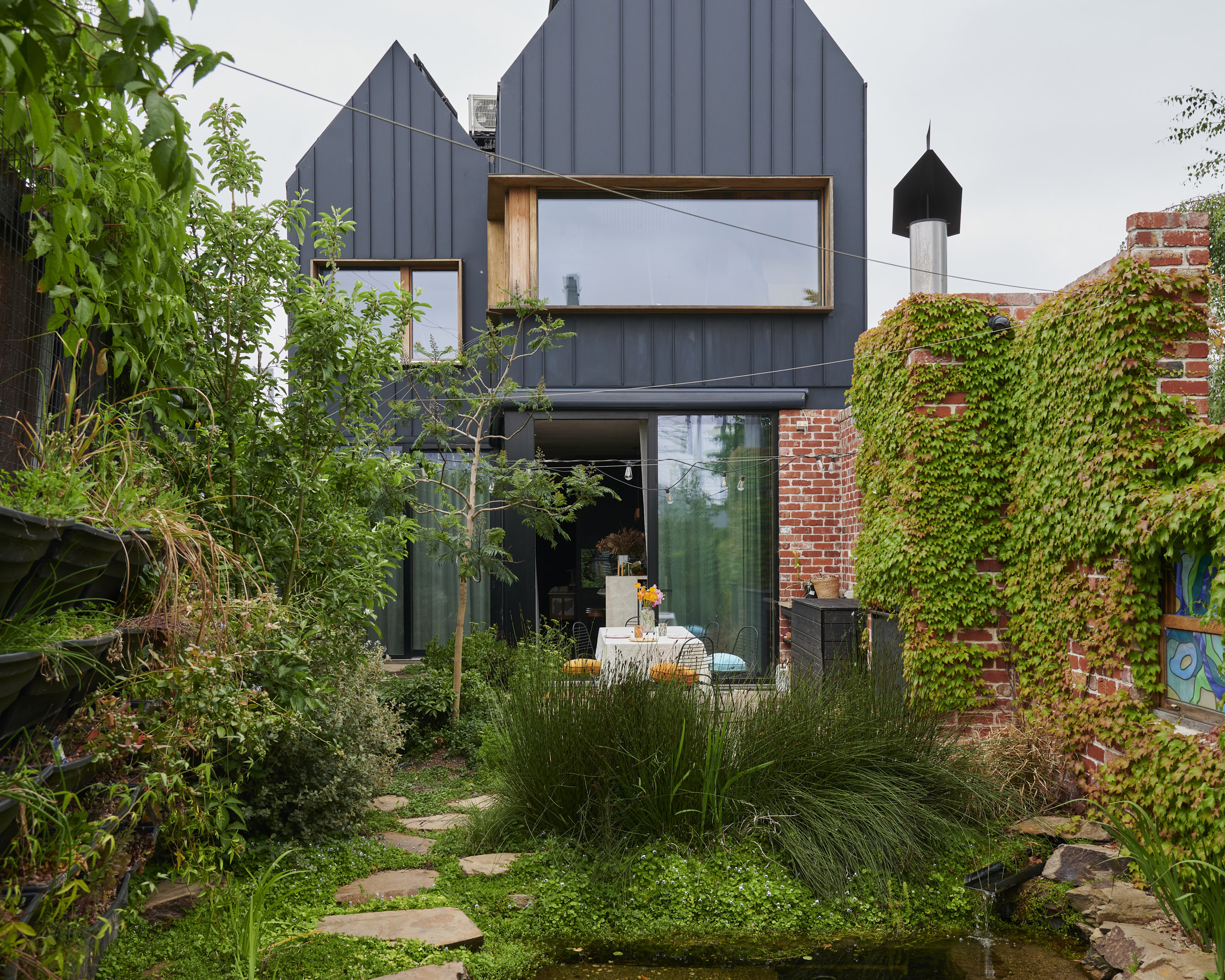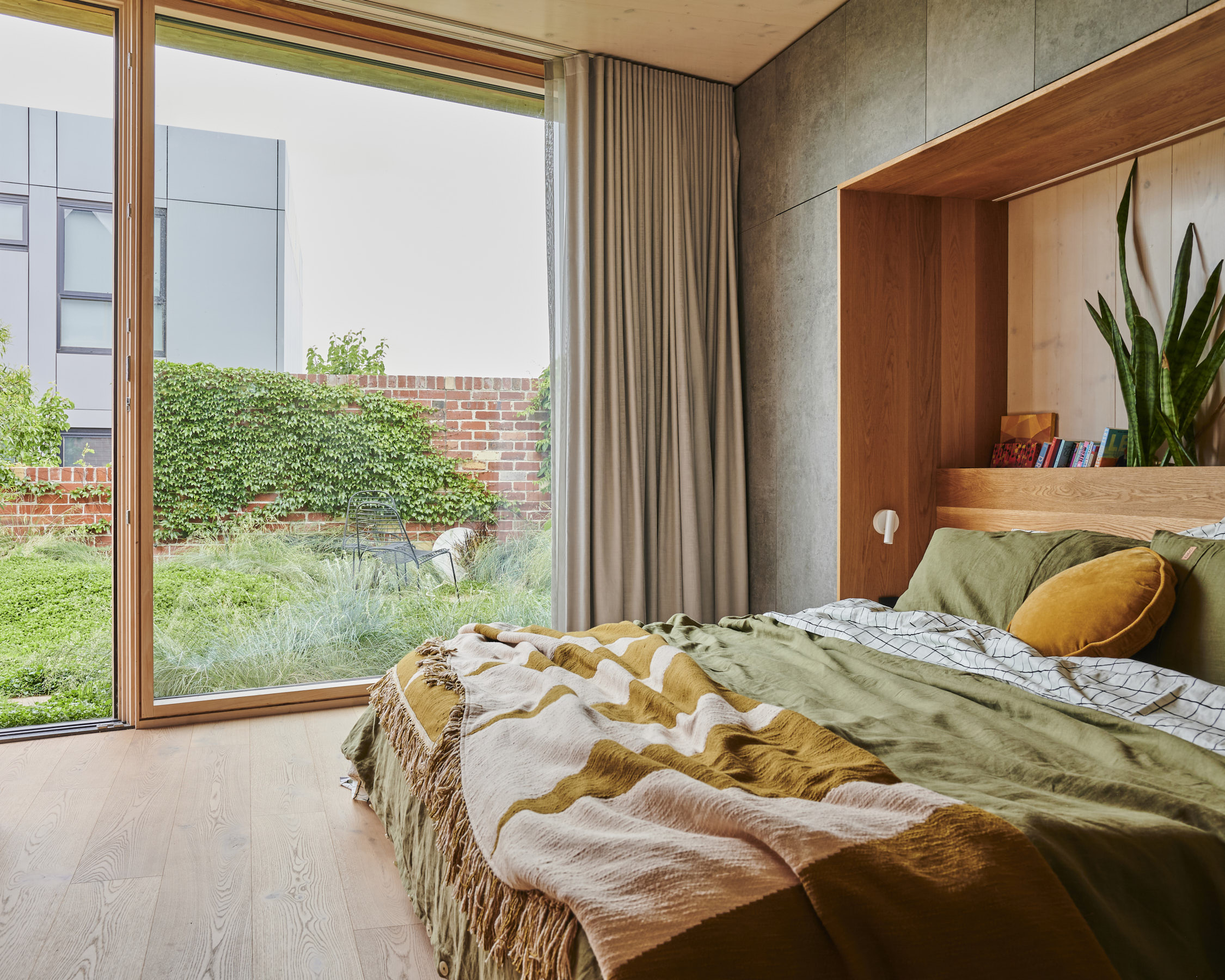This week on the Home Life Series, we’re taking a look into the future of sustainable living as we journey through Felicity and Marc Bernstein’s carbon zero Coburg home.
When the Bernstein’s stumbled across this undevelopable site wedged between a train line and laneway, the inherent architects within them couldn’t resist the ‘near impossible’ challenge. Whilst not being an easy journey, the couple have successfully created a modern, innovative, nordic-inspired home with the best carbon rating you could possibly have.
The cherry on top to their inspiring commitment to sustainability is the recent release of their first book, Ninety Nine Green Ideas, which Kip&Co are honoured to be featured in! Read on to learn more about this one of a kind, cutting-edge, sustainable home and the couple's top three favourite ways to update your interiors consciously.
Hi Felicity! We’re very excited to be welcomed through your conscious Coburg home. First up, tell us a little bit about yourself and who lives here with you?
I am a sustainable designer and intuitive interior designer. I am lucky to share my dream home with my amazing husband who is my soulmate and partner in business and life. We have the pleasure to enjoy the company of our three beautiful children and our golden retriever, Sox.
What a unique spot! You’ve managed to turn an undevelopable site wedged between a train line and laneway into an architect's delight. What were your first thoughts when you stumbled across this piece of land?
What an opportunity! While this property at first sight could easily look like a near impossible site to place an ordinary home on, it was a welcome challenge for us. We love thinking outside the box and felt that to leave a site like this vacant in a prime location would be such a waste. With Melbourne growing yearly and a continuing lack of liveable homes close to the city, the idea to work with urban densification while establishing as much greenery as possible seemed a fantastic goal to work towards. While it certainly hasn’t been an easy journey, we enjoyed every step. From extensive research, to finding solutions for challenges associated with the unusual shape and location of the site, like difficult and tight access, building on the boundary, utilising the space in a way that allows flow and the feeling of space.
We absolutely love the little oasis in the middle of the urban jungle we have been lucky to be able to create, and hope we can inspire many to not give up on their dreams. We encourage everyone to embrace quality over quantity and to build a forever home that is elevating their life, while leaving our world a little better than before.
You are the CEO and director of Melbourne design practice Hütt, whose first project was your family home. Hütt focuses on delivering the future of zero carbon housing by utilizing the latest carbon free energy technologies. What was the overall vision for your home?
Very nicely said. The Hütt homes and enterprise are the brainchild of Melbourne Design Studios (MDS), which is where all the design work happens. With this, we wanted to create "tomorrow's house" today. A home that makes you smile in style and enjoy a fun, health enhancing and comfortable lifestyle, while you make a positive contribution to our planet and make the world a better place. I like to compare it to a Tesla - it is a bit like a Tesla but as a home: future ready fun, offering ultimate lifestyle and performance while making the world a better place. We wanted to inspire people to say yes to a better future and to invest in something that will last.
Using future technologies just naturally makes sense. The carbon zero home is proud to have the best carbon rating you could possible have. It is a Passivhaus Premium, producing more energy than it needs for its operations, it never requires heating during our Victorian winters, and while it's always a comfortable 21-23 degrees, it only needs minimal cooling powered by the sun. The home comes with filtered fresh air supply 24/7, delivering the freshest filtered air even when it's uncomfortable outside or in hay fever season. On top of that we like to strive for a home that is heathy and relaxing, like being on a holiday everyday.
Your home demonstrates that a super sustainable approach to design does not have to exclude lifestyle, luxury and welcoming contemporary architecture. Talk us through some of the design features and materials used in your home that are natural and eco-conscious?
Pretty much every single material that went into our home has been assessed based on these criteria. The biggest ones are:
1. We used a lot of FSC certified (and also cradle to cradle certified) timber, making sure everything that is used is replanted. Timber is natural, biodegradable in the end and is a huge carbon sponge. That means while it's producing oxygen during its lifetime, it absorbs CO2 from the atmosphere and stores it for good, helping to reduce greenhouse gases in the atmosphere. Our home is build from CLT (cross laminated timber), with wood fibre insulation. It not only offers this super thermal performance and acoustics it also makes it easy to build an airtight structure, making it easy to keep a comfortable climate inside the home independent from the outside conditions. Lastly timber is considered a biophilic material. That means a natural material that we connect with on a human level. It makes us feel balanced, warm and welcome.
2. We used a lots of plants indoor and outdoors. A flat roof was turned into a roof landscape, and we included built in planter boxes and green walls inside. In our garden we have an aquaponic system, which means the water in our natural pond is pumped through a vertical garden. This is a genius invention whereby the plants are naturally fertilized with fish poop in the water and the plant run off is providing food for the fish. It's basically like its own little ecosystem.
3. We used clay render with limewash paint. This is a natural and breathable material which maintains a much better indoor air quality without being loaded with toxic ingredients. It's basically completely natural.
We’re absolutely honoured to be featured in your first ever book release, Ninety Nine Green Ideas. This book is all about green ideas for the home, inspiring readers to make easy, simple and beautiful interior choices (which we LOVE!). Why do you think it's important for people to make conscious choices when it comes to interior design?
We often talk about the government and politicians and hope they bale us out of the climate situation we are in. And that's all good, but it will take time. And there is a lot every single one of us can do to make sure we can leave a wonderful planet for our children. Many people we spoke to found themselves overwhelmed and worried, and often didn't know where to find better choices. We wanted to inspire people and make it easy and fun to make our world a better place. We all buy products regularly for our homes and lives. Starting with those is a perfect opportunity for everyone to make better and more healthy choices for their family and themselves while making a good choice for the planet. Lots of little choices will make a big difference.
New Turkish towels coming soon!
For those who can’t get their hands on a book, can you give us your favourite 3 ways readers can update their home in an environmentally conscious way?
1. Buy something with purpose you'll love and cherish for years as this will keep things out of landfill. Opt for natural materials and even better organically grown. It will not only make you feel good, but it's super healthy for you and good for the planet. For example, I love linen, organic cotton or banana fibre, but there are many more options.
2. Look for recycled products or up-cycle something yourself. These can be the most surprising things that you can create yourself or get from amazing makers. One of our favourites is a set of glass tumblers made from recycled wine bottles.
3. Look for Fair Trade or locally and ethically made products. If people are paid well they can pay their contribution to a better world too and it's just simply fair to look after the makers and the stores behind the products we buy as well. Where do they come from and where do they go? And what has their journey been? While the world isn't full of perfect options yet, there is a lot of green goodness we can create with every single choice we get right.











-(3)-v1704672696940.png)

-(5)-v1704766531958.png)
-(4)-v1704672794472.png)



